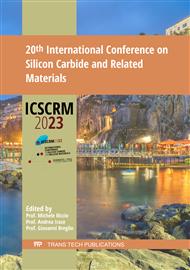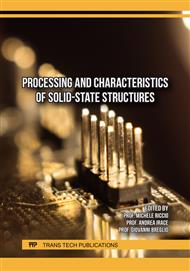p.23
p.31
p.37
p.45
p.51
p.59
p.65
p.71
p.79
Temperature Dependence of 4H-SiC Gate Oxide Breakdown and C-V Properties from Room Temperature to 500 °C
Abstract:
Silicon carbide (SiC) is intrinsically more suitable for high temperature operation than silicon. However, for devices and circuits based on metal-oxide-semiconductor, high temperature behavior of gate oxides is still under investigation. This work aims to provide insights on how temperatures from room temperature up to 500 °C affect gate oxide properties of metal-oxide-semiconductor structures. Characterization is performed by current-voltage (I-V) and capacitance-voltage (C-V) measurements with different SiC and polysilicon gate electrode doping types. Increasing breakdown voltages were observed with higher temperatures for n-type SiC doping, while p-type ones break down at lower voltages. Polysilicon doping type only has minor impact on the breakdown voltage but influences the I-V behavior. High temperatures increase the probability of strong inversion being observable in C-V investigation. Regarding the I-V results, it can be stated that the 55 nm gate oxide used in the utilized HT CMOS technology has breakdown voltages above absolute values of around 55 V, independent of any doping types, and no significant current could be observed within the intended 20 V operation range of the technology.
Info:
Periodical:
Pages:
51-58
Citation:
Online since:
August 2024
Authors:
Permissions:
Share:
Citation:



